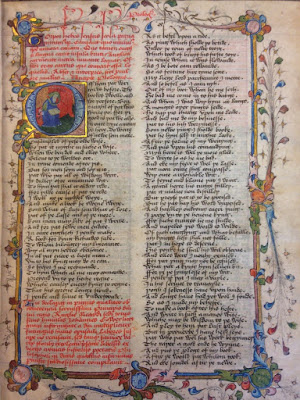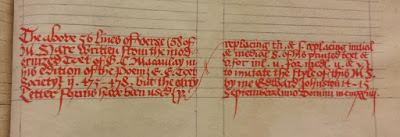Greetings bibliophiles! My name is Sony Mathew, an intern who has been working in the collections department at the Rosenbach as part of the Arts Intern program hosted by Studio in a School. The program allows undergraduate students such as myself to experience what it would be like to work at a museum. This summer I was tasked to develop a hands-on-tour on Book Arts, where visitors could get the chance to learn about medieval manuscripts, traditional book-making processes, and see aesthetically appealing features of some of the rare books in our collection.
Sound familiar? Our associate curator, Kathy Haas (and my supervisor) wrote a blog post about it last week and included the French Book of Hours showcased in the tour. Last Sunday (8/7) was the grand opening of the tour to the public, given by yours truly, and I am proud to say we had an amazing turnout!
For this week’s blog post, I thought it would be cool to share a bit about yet another book that was shown in my tour – a 14th century Middle English poem titled Confessio Amantis, or the Lover’s Confession, by John Gower.
In at least 31,000 lines, this poem delves into the sorrows of an aging lover who upon summoning the goddess of love, Venus, discovers he is dying from lack of love. Venus summons her chaplain, Genius, who hears the lover’s confession and guides him through a series of medieval courtly love traditions using seven deadly sins as narrative frameworks throughout the course of the confession.

In the prologue of the book, it is revealed that Gower wrote the Confessio Amantis in English as a request from King Richard II who was concerned that very few books were written in the vernacular tongue – and rightly so, considering that most medieval texts were written in Latin for liturgical purposes. This work is considered to be an important contribution to secular and courtly love literature in English, and Gower, who was also a friend to Geoffrey Chaucer, may have influenced him to write the Canterbury Tales in Middle English as well.
We at the Rosenbach have a 1450 copy of Confessio Amantis, however, it was not always complete; the final leaf of the manuscript containing the last 56 lines of the poem went missing. So its previous owner, the Earl of Aberdeen, commissioned the calligrapher Edward Johnston to recreate the missing leaf by imitating the same style as the rest of the book.

In his colophon (a note at the end of the manuscript) Johnston reveals that he copied the last verses from a modernized edition of the text by G.L. Macaulay and signs his name and the date at the end, placing his mark on the newly added manuscript leaf.
The rest of the book is filled with beautiful gold illumination, paint, and miniature illustrations in the prologue, including an image of Gower himself.
There are so many books I’d love to post about, but if you are interested in seeing or hearing more, you can look forward to another run of the Book Arts tour sometime in the month of November.
It was a great experience for me to be able to create this tour during the course of the eight weeks I’ve interned at the Rosenbach, and I could not have done so without the guidance and support of the Rosenbach staff – so a big thank you to them!
Sony Mathew is a Collections Intern at the Rosenbach and rising senior at Lafayette College, majoring in English and Art.
